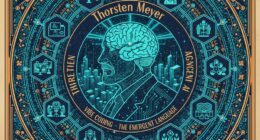Elon Musk is a visionary tech entrepreneur who’s transforming transportation, energy, and space exploration through Tesla and SpaceX. He pioneered reusable rockets, making space missions cheaper and more sustainable, and revolutionized electric vehicles with Tesla’s innovative and high-performance models. Musk’s work also extends into renewable energy, brain–machine interfaces, and social media influence. If you want to explore how he’s shaping the future across multiple industries, there’s much more to uncover.
Key Takeaways
- Elon Musk is a pioneering entrepreneur behind Tesla, revolutionizing electric vehicles and renewable energy solutions.
- He founded SpaceX, transforming space exploration with reusable rockets and plans for Mars colonization.
- Musk’s innovations include advanced battery storage, neural interfaces via Neuralink, and AI development through xAI.
- He emphasizes technological sustainability, reducing launch costs, and expanding clean energy deployment globally.
- Musk’s influence extends to social media, shaping digital discourse and public perception of technology and innovation.
Early Beginnings and Entrepreneurial Foundations

Elon Musk’s journey begins in Pretoria, South Africa, where he was born on June 28, 1971, to a Canadian model and dietitian mother and a South African engineer father. Growing up with a brother and sister, he faced childhood challenges like bullying and tough school environments, shaping his resilience. He developed an early passion for technology, teaching himself programming at age 10 with a Commodore VIC-20 manual and selling his first video game, *Blastar*, at 12 for $500. His love for science fiction and fantasy fueled his imagination. In 1988, he left South Africa to avoid military service and pursue better opportunities abroad. Moving to North America, he studied physics and economics, laying the groundwork for his entrepreneurial ventures and future innovations. Embracing a design thinking approach, Musk has continually adapted his ideas to meet real-world needs and challenges.
Pioneering Space Exploration With Spacex

You can’t ignore how SpaceX’s reusable rockets have revolutionized space travel, drastically cutting costs and increasing launch frequency. Their ambitious plans to colonize Mars rely on powerful vehicles like Starship, designed for deep space missions. With key milestones in commercial spaceflight and ongoing innovations, SpaceX continues to push the boundaries of human exploration beyond Earth. Additionally, the development of advanced rocket maintenance techniques ensures the reliability and reusability of their spacecraft for future missions.
Reusable Rocket Technology
Have you ever wondered how SpaceX revolutionized space travel? They pioneered reusable rocket technology, aiming for full and rapid reuse to cut launch costs. In 2015, they achieved a milestone with the first successful booster landing, landing on a drone ship. This breakthrough allowed boosters to be recovered, refurbished, and reused multiple times—up to 15 or more—significantly lowering expenses. SpaceX’s boosters use grid fins and cold gas thrusters for precise landings on ships or ground pads. After setbacks like the 2016 explosion, they refined their approach, demonstrating rapid reflight in 2017. Reusability has slashed launch costs by up to 40%, made satellite deployment more affordable, and disrupted the industry. This technology continues to evolve, laying the foundation for future space exploration. Enhanced recovery techniques further improve the efficiency and reliability of reusable rockets, ensuring sustainable space missions.
Mars Colonization Goals
SpaceX’s advancements in reusable rocket technology have paved the way for ambitious plans to colonize Mars. You’ll see uncrewed cargo missions starting around 2026, delivering equipment, habitats, and supplies ahead of crewed landings. The first crewed mission, expected no earlier than 2029, aims to establish basic infrastructure with about 12 people. Construction of Mars Base Alpha will include habitats, methane and oxygen production plants, and transparent domes for crops. Local resource utilization, like extracting water ice and producing methane via atmospheric CO2, will support self-sufficiency and reduce reliance on Earth. Over time, the goal is to expand into a self-sustaining city, scaling up to millions of residents. Infrastructure like roads, landing pads, and global communication networks will underpin this ambitious effort. Launches to maximize transfer windows, occurring approximately every 26 months. Additionally, advancements in spacecraft propulsion technology will be crucial to reduce travel time and improve mission efficiency.
Commercial Spaceflight Milestones
How did a private company revolutionize space exploration? SpaceX broke barriers with milestones like the Falcon 1 reaching orbit in 2008, proving private-sector capability. The Dragon spacecraft became the first commercial vehicle to reach and return from orbit in 2010 and dock with the ISS in 2012, enabling cargo and crew missions. The Falcon 9 introduced reusability, landing successfully on land in 2015 and on drone ships in 2016, with over 120 flights by 2022. Falcon Heavy, launched in 2018, became the most powerful rocket, supporting heavy payloads and interplanetary missions. In 2020, Crew Dragon carried NASA astronauts, establishing a domestic human spaceflight capability. These milestones transformed space access, making it faster, cheaper, and more reliable. Additionally, advancements in rocket reusability have significantly reduced launch costs and increased mission frequency.
Transforming Transportation: Tesla’s Rise
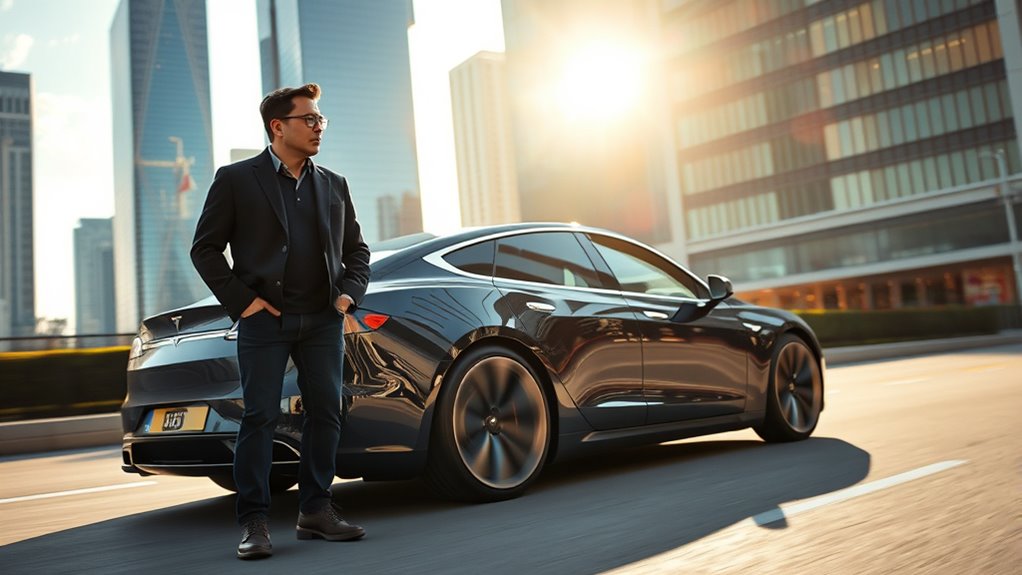
Tesla’s rise has fundamentally transformed transportation by making electric vehicles (EVs) mainstream and reshaping industry standards. When you consider the launch of the Roadster in 2008, it proved EVs could be high-performance, with a 245-mile range and acceleration under 4 seconds. As Tesla went public in 2010, it gained the capital to scale production, later launching the Model S, which won awards and topped sales charts. The introduction of Model X, 3, and Y expanded Tesla’s reach into luxury and mass-market segments, with the Model Y becoming the best-selling EV globally by 2023. Advanced manufacturing, battery tech, and charging infrastructure pushed EV adoption forward. Tesla’s innovations challenged traditional automakers, shifting perceptions and proving electric vehicles are viable, sustainable transportation options for the future. Tesla’s market valuation surpassed $1 trillion in 2022, reaffirming its position as a leader in the industry. Additionally, Tesla’s focus on battery technology has been a critical factor in driving innovation and efficiency across their vehicle lineup.
Expanding Into Sustainable Energy Solutions
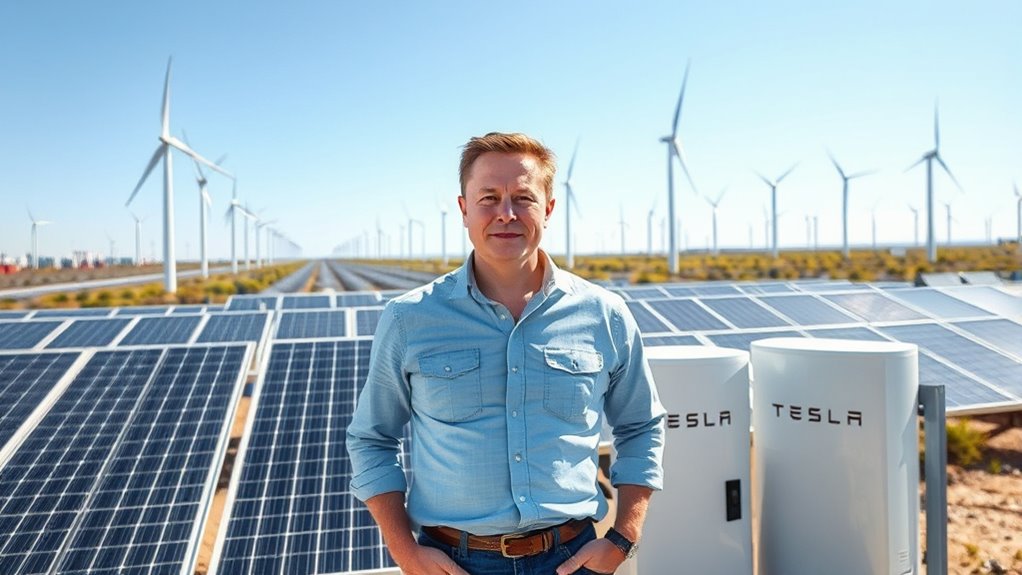
Elon Musk is pushing the boundaries of sustainable energy with innovative projects like space-based solar fusion reactors that provide constant, clean power. Tesla’s advancements in energy storage, especially hydrogen and large-scale batteries, aim to make renewable energy more reliable and accessible. These efforts are transforming how we harness, store, and distribute energy for a greener future. Additionally, integrating solar energy solutions into various sectors is crucial for maximizing renewable energy utilization.
Solar Energy Innovations
Are you aware of the groundbreaking innovations transforming solar energy into a cornerstone of sustainable power? Elon Musk’s initiatives are pushing the boundaries of what’s possible. The Space-Based Solar Fusion Reactor proposes a system where orbital solar panels collect constant sunlight, bypassing weather and day-night cycles. This energy is transmitted via microwaves to Earth, providing a reliable, clean power source. Meanwhile, Tesla’s low-cost solar panels, priced around $0.19 per watt, make solar energy more accessible and affordable, capable of powering entire regions with just 100 miles by 100 miles of panels. Advances in ultralight materials, miniaturization, and reusable launches further enhance deployment efficiency. These innovations aim to revolutionize global energy supply, making sustainable, abundant, and uninterrupted solar power a practical reality. Technological advancements in materials and manufacturing are critical to scaling these solutions globally and cost reduction strategies further.
Energy Storage Advancements
Have you noticed how energy storage technology is revolutionizing the way we harness and rely on renewable power? Tesla’s energy storage systems, like the Megapack, are a game-changer, with 31.4 GWh deployed in 2024. These large-scale lithium-ion batteries, capable of storing up to 3.9 MWh each, help stabilize power grids and replace fossil fuel plants. Tesla’s storage revenue soared from $2 billion in 2020 to over $10 billion in 2024, making it a core growth driver. Their expansion includes multiple Megafactories worldwide, increasing production capacity. Despite some recent setbacks due to geopolitical and supply chain issues, Tesla continues to lead in sustainable energy infrastructure. These advancements make renewable energy more reliable, reduce emissions, and ensure grid resilience, pushing us closer to a clean energy future. Global battery storage market is projected to grow 27% annually, further accelerating Tesla’s impact in the industry. Additionally, ongoing innovations in energy storage technology are critical for enhancing the efficiency and scalability of renewable energy solutions.
Innovation in Brain–Machine Interfaces and Infrastructure

Innovations in brain–machine interfaces (BMIs) are transforming how humans interact with technology, with Neuralink leading the charge. You benefit from advances like:
- The use of thin electrode threads that detect neural signals, enabling seamless computer interaction.
- Robot-assisted surgery that improves precision and safety during electrode implantation.
- Applications in neurorehabilitation, helping treat sensory and motor disabilities.
- Successful human trials, marking a milestone in restoring neural functions.
BCIs decode brain signals to understand user intentions, such as movement or speech.
Neuralink’s infrastructure supports this progress with facilities in California and Texas, alongside plans for expansion. Their high-resolution recording technology and biocompatible probes enhance neural data collection. Despite ethical challenges, Neuralink’s breakthroughs push forward the possibilities of brain–machine integration, especially as AI security concerns are increasingly relevant to safeguarding neural data.
Impact on Social Media and Digital Communication
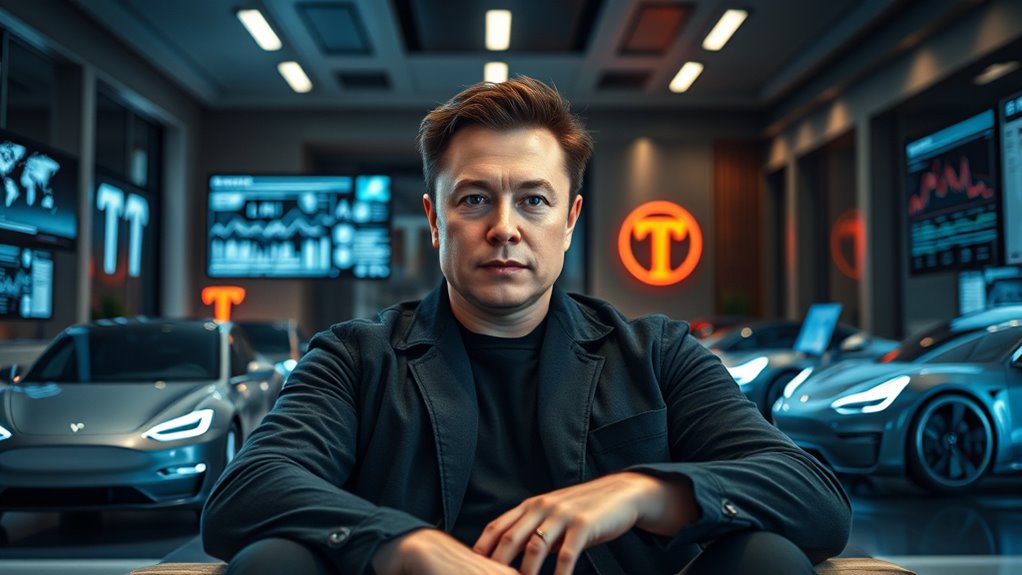
Elon Musk’s influence extends beyond technological breakthroughs into the sphere of social media and digital communication, reshaping how information is shared and consumed. Since acquiring X, engagement with fact-checkers and pro-science accounts dropped by 52%, shifting focus toward more extreme outlets. This change has led to increased polarization, with Musk’s public perception divided along political lines—favorability is high among Republicans but low among Democrats. His tweets can sway markets and public opinion, illustrating his power in digital spaces. Media coverage of Musk is overwhelmingly negative—over 80%—which intensifies polarization and scrutiny. As a result, fact-checking has weakened, and misinformation spreads more easily, transforming the platform into a less reliable space for accurate information.
| Aspect | Impact |
|---|---|
| Fact-Checker Engagement | Declined sharply post-2022 |
| Public Perception | Highly polarized and negative |
| Media Coverage | Mostly negative, amplifies controversy |
The Legacy and Future Visions of Elon Musk
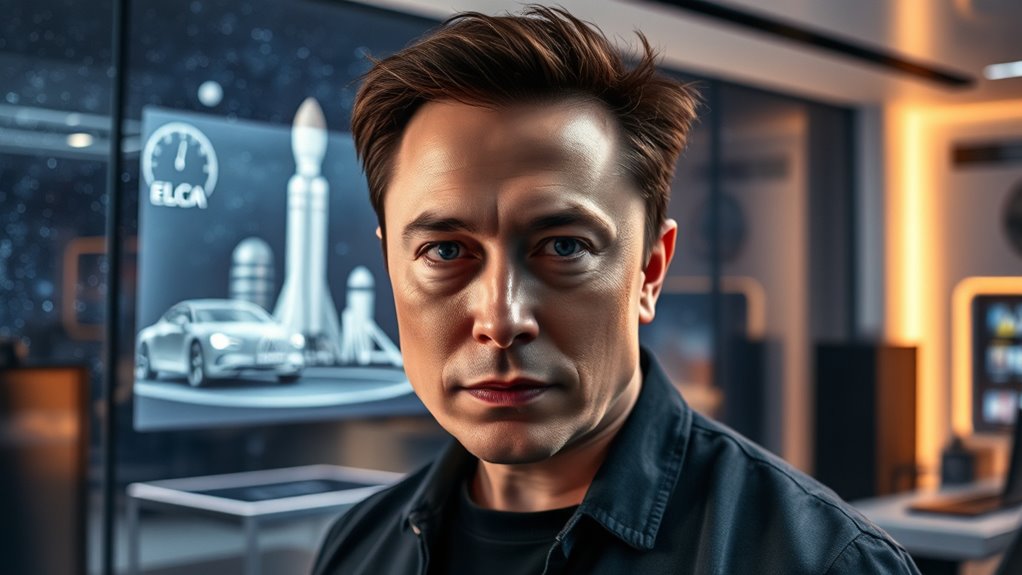
What will be Elon Musk’s lasting impact on the future of technology and society? His vision extends beyond current innovations, shaping a sustainable and multiplanetary future. Here’s what you should remember:
- Tesla’s leadership in electric vehicles and clean energy has transformed transportation and energy consumption worldwide. Tesla holds approximately 20% of the global BEV market share in 2023, demonstrating its dominance in the electric vehicle industry.
- SpaceX’s reusable rockets and plans for Mars colonization redefine space exploration and humanity’s place in the universe.
- Musk’s ventures like Neuralink and xAI aim to integrate AI safely with humans, potentially revolutionizing cognition and addressing neurological diseases.
- His impact on business models emphasizes vertical integration and risk-taking, pushing industries toward rapid innovation.
Musk’s legacy lies in pushing boundaries, blending technology with bold visions for a sustainable, multi-planetary future.
Frequently Asked Questions
What Are Elon Musk’s Plans for Interplanetary Colonization?
Your question explores humanity’s plans to establish colonies beyond Earth. SpaceX aims to develop reusable rockets and spacecraft, like Starship, to transport people and cargo to Mars. By producing thousands of ships, they intend to build a self-sustaining colony using local resources, with infrastructure for transportation, power, and life support. The goal is to make humans a multiplanetary species, ensuring long-term survival and growth on Mars.
How Does Musk Prioritize His Multiple Technology Ventures?
Imagine juggling glowing orbs, each representing a venture with its own vibrant energy. You prioritize by setting clear, ambitious goals that serve as your guiding stars, focusing on what truly moves the needle. You dedicate specific days to each project, delegate heavily, and rely on trusted teams. This strategic balancing act helps you manage complex responsibilities, ensuring every venture advances without losing sight of your long-term vision.
What Challenges Has Musk Faced in Scaling Tesla’s Production?
You face challenges in scaling production when shifting from custom-built to mass manufacturing, leading to delays and inefficiencies. Supply chain issues, like parts shortages and over-reliance on single suppliers, cause bottlenecks. Over-automation at factories results in breakdowns and increased costs. Financial pressures add stress, especially during early growth phases, forcing strategic adjustments. Despite these hurdles, you manage to improve processes and achieve profitability over time.
How Does Musk Envision the Future of Artificial Intelligence?
Imagine AI as a river rushing toward uncharted territories. You see it transforming every sector, surpassing human skills, and powering robots that tackle real-world problems. Musk envisions AI as an evolving intelligence, rewriting human knowledge and working seamlessly with robotics. You recognize the importance of safety, ethics, and oversight to keep this flood of innovation directed for humanity’s benefit, shaping a future where AI helps us solve the impossible.
What Is Musk’s Approach to Managing Social Media Controversies?
You see that managing social media controversies involves a mix of bold strategies and public defenses. You often use high-volume, provocative posting to stay relevant and shape discourse. When criticism arises, you frame it as bias or unfair scrutiny, sometimes backtracking. You rely on transparency and ambiguity, deleting or rephrasing posts, while emphasizing free speech principles. This approach keeps you in the spotlight and controls the narrative around your actions.
Conclusion
As you follow Elon Musk’s journey, remember he’s shaping a future as bold as Icarus’s flight—aiming higher than most dare. His relentless drive pushes boundaries, reminding you that innovation often requires risking it all. Like a modern Da Vinci, Musk blends art and science to redefine what’s possible. Keep watching, because his vision isn’t just about technology—it’s about rewriting the story of what humanity can achieve, soaring toward a horizon that’s forever expanding.








